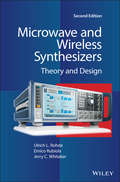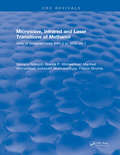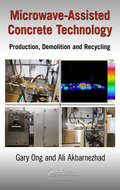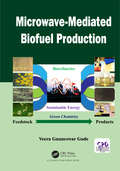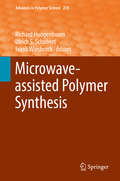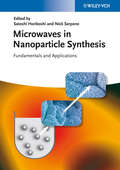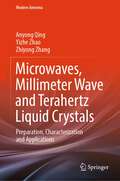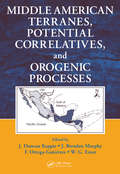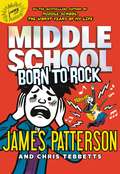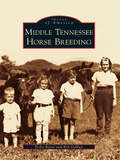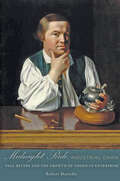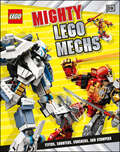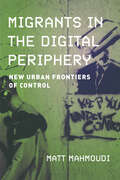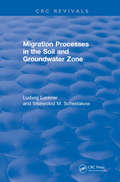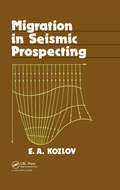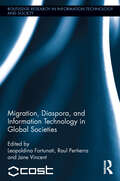- Table View
- List View
Microwave and Wireless Synthesizers: Theory and Design
by Ulrich L. Rohde Jerry C. Whitaker Enrico RubiolaThe new edition of the leading resource on designing digital frequency synthesizers from microwave and wireless applications, fully updated to reflect the most modern integrated circuits and semiconductors Microwave and Wireless Synthesizers: Theory and Design, Second Edition, remains the standard text on the subject by providing complete and up-to-date coverage of both practical and theoretical aspects of modern frequency synthesizers and their components. Featuring contributions from leading experts in the field, this classic volume describes loop fundamentals, noise and spurious responses, special loops, loop components, multiloop synthesizers, and more. Practical synthesizer examples illustrate the design of a high-performance hybrid synthesizer and performance measurement techniques—offering readers clear instruction on the various design steps and design rules. The second edition includes extensively revised content throughout, including a modern approach to dealing with the noise and spurious response of loops and updated material on digital signal processing and architectures. Reflecting today’s technology, new practical and validated examples cover a combination of analog and digital synthesizers and hybrid systems. Enhanced and expanded chapters discuss implementations of direct digital synthesis (DDS) architectures, the voltage-controlled oscillator (VCO), crystal and other high-Q based oscillators, arbitrary waveform generation, vector signal generation, and other current tools and techniques. Now requiring no additional literature to be useful, this comprehensive, one-stop resource: Provides a fully reviewed, updated, and enhanced presentation of microwave and wireless synthesizers Presents a clear mathematical method for designing oscillators for best noise performance at both RF and microwave frequencies Contains new illustrations, figures, diagrams, and examples Includes extensive appendices to aid in calculating phase noise in free-running oscillators, designing VHF and UHF oscillators with CAD software, using state-of-the-art synthesizer chips, and generating millimeter wave frequencies using the delay line principle Containing numerous designs of proven circuits and more than 500 relevant citations from scientific journal and papers, Microwave and Wireless Synthesizers: Theory and Design, Second Edition, is a must-have reference for engineers working in the field of radio communication, and the perfect textbook for advanced electri
Microwave, Infrared, and Laser Transitions of Methanol Atlas of Assigned Lines from 0 to 1258 cm-1: Atlas Of Assigned Lines From 0 To 1258 Cm
by Giovanni MoruzziThis unique atlas presents the recorded spectrum of CH3OH, the main isotopic species of methanol, in the range 28-1258 cm-1. The spectral plot is accompanied by a list of all currently assigned rotation-torsion-vibration lines in the absorption spectrum of methanol. The list of nearly 35,000 transitions spans all of the known microwave transitions, as well as the region of coincidence with CO2 laser emissions.
Microwave, Radar & RF Engineering: With Laboratory Manual
by Prakash Kumar ChaturvediThis is a textbook for upper undergraduate and graduate courses on microwave engineering, written in a student-friendly manner with many diagrams and illustrations. It works towards developing a foundation for further study and research in the field. The book begins with a brief history of microwaves and introduction to core concepts of EM waves and wave guides. It covers equipment and concepts involved in the study and measurement of microwaves. The book also discuses microwave propagation in space, microwave antennae, and all aspects of RADAR. The book provides core pedagogy with chapter objectives, summaries, solved examples, and end-of-chapter exercises. The book also includes a bonus chapter which serves as a lab manual with 15 simple experiments detailed with proper circuits, precautions, sample readings, and quiz/viva questions for each experiment. This book will be useful to instructors and students alike.
Microwave-Assisted Concrete Technology: Production, Demolition and Recycling
by K.C. Gary Ong Ali AkbarnezhadMicrowave Technology: A Powerful TechniqueThe first book to combine microwave-assisted heating technology and concrete technology (covering production, demolition, and recycling), Microwave-Assisted Concrete Technology: Production, Demolition and Recycling explains the underlying concepts and fundamentals involved in the microwave-assisted heating of concrete. While most books on microwave heating focus on the behavior of microwaves, this text centers on the response of materials subjected to microwaves, and specifically concentrates on materials used in the concrete industry. A ready reference for the design of microwave-based equipment, the book describes how microwave-assisted heating technology may be harnessed in the production, demolition, and recycling of concrete. It covers microwave-assisted applications, the design concepts of microwave heating systems (generators and applicators) used in microwave-assisted concrete-processing methods, and process control techniques used to monitor the condition of concrete during the heating process. Learn How to use the Microwave-Assisted Heating Process for IndustryThe book is written from the perspective of modern practitioners in the construction industry, and addresses the technological, scientific, and environmental issues involved in replacing conventional approaches with microwave heating. The authors categorize the applications of microwave heating in concrete technology into three areas: microwave-assisted accelerated curing of concrete, microwave-assisted selective demolition and drilling of concrete, and the microwave-assisted recycling of concrete. They discuss sustainability and the environmental impact of incorporating sustainable concrete production, demolition, and recycling using microwave-assisted heating technologies, and environmentally friendly microwave heating applications. This text covers: The basics of concrete-microwave field interactions Microwave-assisted concrete technologies for use in the production, demolition, and recycling of concrete as well as the control mechanisms required to ensure the efficiency of these methods The design of microwave heating applicators Microwave-Assisted Concrete Technology: Production, Demolition and Recycling does not require a familiarity with electromagnetism science and can be easily understood by civil engineers as well as by readers with little or no engineering background.
Microwave-Mediated Biofuel Production
by Veera G. GudeThis book focuses on chemical syntheses and processes for biofuel production mediated by microwave energy. This is the first contribution in this area serving as a resource and guidance manual for understanding the principles, mechanisms, design, and applications of microwaves in biofuel process chemistry. Green chemistry of microwave-mediated biofuel reactions and thermodynamic potentials for the process biochemistry are the focus of this book. Microwave generation, wave propagation, process design, development and configurations, and biofuel applications are discussed in detail.
Microwave-assisted Extraction for Bioactive Compounds
by Giancarlo Cravotto Farid ChematWith increasing energy prices and the drive to reduce CO2 emissions, food industries are challenged to find new technologies in order to reduce energy consumption, to meet legal requirements on emissions, product/process safety and control, and for cost reduction and increased quality as well as functionality. Extraction is one of the promising innovation themes that could contribute to sustainable growth in the chemical and food industries. For example, existing extraction technologies have considerable technological and scientific bottlenecks to overcome, such as often requiring up to 50% of investments in a new plant and more than 70% of total process energy used in food, fine chemicals and pharmaceutical industries. These shortcomings have led to the consideration of the use of new "green" techniques in extraction, which typically use less solvent and energy, such as microwave extraction. Extraction under extreme or non-classical conditions is currently a dynamically developing area in applied research and industry. Using microwaves, extraction and distillation can now be completed in minutes instead of hours with high reproducibility, reducing the consumption of solvent, simplifying manipulation and work-up, giving higher purity of the final product, eliminating post-treatment of waste water and consuming only a fraction of the energy normally needed for a conventional extraction method. Several classes of compounds such as essential oils, aromas, anti-oxidants, pigments, colours, fats and oils, carbohydrates, and other bioactive compounds have been extracted efficiently from a variety of matrices (mainly animal tissues, food, and plant materials). The advantages of using microwave energy, which is a non-contact heat source, includes more effective heating, faster energy transfer, reduced thermal gradients, selective heating, reduced equipment size, faster response to process heating control, faster start-up, increased production, and elimination of process steps. This book will present a complete picture of the current knowledge on microwave-assisted extraction (MAE) of bioactive compounds from food and natural products. It will provide the necessary theoretical background and details about extraction by microwaves, including information on the technique, the mechanism, protocols, industrial applications, safety precautions, and environmental impacts.
Microwave-assisted Polymer Synthesis
by Ulrich S. Schubert Richard Hoogenboom Frank WiesbrockThe series Advances in Polymer Science presents critical reviews of the present and future trends in polymer and biopolymer science. It covers all areas of research in polymer and biopolymer science including chemistry, physical chemistry, physics, material science. The thematic volumes are addressed to scientists, whether at universities or in industry, who wish to keep abreast of the important advances in the covered topics. Advances in Polymer Science enjoys a longstanding tradition and good reputation in its community. Each volume is dedicated to a current topic, and each review critically surveys one aspect of that topic, to place it within the context of the volume. The volumes typically summarize the significant developments of the last 5 to 10 years and discuss them critically, presenting selected examples, explaining and illustrating the important principles, and bringing together many important references of primary literature. On that basis, future research directions in the area can be discussed. Advances in Polymer Science volumes thus are important references for every polymer scientist, as well as for other scientists interested in polymer science - as an introduction to a neighboring field, or as a compilation of detailed information for the specialist. Review articles for the individual volumes are invited by the volume editors. Single contributions can be specially commissioned. Readership: Polymer scientists, or scientists in related fields interested in polymer and biopolymer science, at universities or in industry, graduate students
Microwaves Photonic Links: Components and Circuits
by Catherine Algani Anne-Laure Billabert Christian RumelhardThis book presents the electrical models for the different elements of a photonic microwave link like lasers, external modulators, optical fibers, photodiodes and phototransistors. The future trends of these components are also introduced: lasers to VCSEL, external modulators to electro-absorption modulators, glass optical fibers to plastic optical fibers, photodiodes to UTC photodiodes or phototransistors. It also describes an original methodology to evaluate the performance of a microwave photonic link, based on the developed elcetrical models, that can be easily incorporated in commercial electrical circuits simulation software to simulate this complete link.
Microwaves in Nanoparticle Synthesis
by Nick Serpone Satoshi HorikoshiFor the first time, this comprehensive handbook presents the emerging field of microwave technology for the synthesis of nanoparticles. Divided into three parts--fundamentals, methods, and applications--it covers topics including microwave theory, scale-up, microwave plasma synthesis, characterization, and more. This offers both an important volume for academic researchers, and a resource for those in industry exploring the applications of nanoparticles in semiconductors, electronics, catalysis, sensors, and more.
Microwaves, Millimeter Wave and Terahertz Liquid Crystals: Preparation, Characterization and Applications (Modern Antenna)
by Zhiyong Zhang Anyong Qing Yizhe ZhaoThis book is the first ever monograph on nematic liquid crystals for microwaves, millimeter waves and terahertz waves. It presents the first hand independent studies on nematic liquid crystals for microwaves, millimeter waves and terahertz waves. This book opens with an introduction to generic liquid crystals and a retrospective review about nematic liquid crystals in microwaves, millimeter waves and terahertz waves. Attention is then focused on the latest in-house progress on microwave, millimeter wave and terahertz nematic liquid crystals. Synthesis and characterization of novel nematic liquid crystals are first presented, followed by indigenous technologies to manufacture functional nematic liquid crystal devices for microwaves, millimeter waves and terahertz waves. A few self-developed representative advanced functional devices are shown to demonstrate the promising perspective of liquid crystals for not only microwaves, millimeter waves and terahertz waves but also many other non-display applications. The presented studies will attract scientists, engineers and students from various disciplines, such as materials, chemical, electrical, biological, and biomedical engineering. The book is intended for undergraduates, graduates, researchers, professionals and industrial practitioners who are interested in developing novel liquid crystals and further extending liquid crystals beyond display.
Mid-Air Zillionaire (AstroKids #9)
by Robert ElmerBook 9 of AstroKids. Miko learns that she's inherited not just a fortune, but an entire planet! Will her new wealth ruin her friendships and happy life on CLEO7? And can she protect her inheritance from a sneaky developer?
Mid-Infrared Fluoride and Chalcogenide Glasses and Fibers (Progress in Optical Science and Photonics #18)
by Pengfei Wang Haitao Guo Xunsi Wang Peiqing Zhang Shunbin Wang Shijie Jia Gerald Farrell Shixun DaiThis book gives an overview on mid-infrared optical glass and fibers laser, it cover the underlying principle, historic background, as well as recent advances in materials processing and enhanced properties for rare earth doped luminescence, spectroscopy lasers, or optical nonlinearity applications. It describes in great detail, the preparation of high purity non-oxide IR glass and fibers to be used as mid-IR fiber laser and supercontinuum sources for optical fiber spectroscopy. It will be useful for academics, researchers and engineers in various disciplines who require a broad introduction to the subject and would like to learn more about the state-of-the-art and upcoming trends in mid-infrared fiber source development, particularly for industrial, medical and military applications.
Middle American Terranes, Potential Correlatives, and Orogenic Processes
by J. Duncan Keppie J. Brendan Murphy F. Ortega-Gutierrez W. G. ErnstConsisting of papers that have appeared recently in International Geology Review, Middle American Terranes, Potential Correlatives, and Orogenic Processes focuses on Middle American terranes in which tectonic processes, including flat-slab subduction, for orogenic development are examined at various times since the late Mesoproterozoi
Middle School: Born to Rock (Middle School #11)
by James Patterson Chris TebbettsIn the next book in James Patterson's bestselling Middle School series, Rafe Khatchadorian's hilarious little sister, Georgia, is back for another rollicking adventure! It's not easy being Rafe Khatchadorian's sister. He's got quite a reputation around school, and Georgia's got it hard enough as is! With a super secret crush on her classmate Sam Marks, a Rube Goldberg machine challenge to dominate, and constant confrontations with vicious Missy Trillin and her evil Princess Patrol to look forward to, Georgia can't help but throw all her energy into the one thing that makes her happy: her kick-butt, all-girl rock band, We Stink! When Georgia's favorite rock band, Lulu and the Handbags, advertise a major music competition where the winner gets to jam with Lulu herself, Georgia will pull all the stops to make sure We Stink wins--even if it means asking her annoying older brother, Rafe, for help! Will his crazy ideas work, or land her in serious trouble?
Middle Tennessee Horse Breeding
by Rob Dehart Perky BeiselBreeding fine horses has been both big business and pastime for Middle Tennesseans since settlers first entered the Cumberland Valley during the American Revolution. The fertile pastures and mild climate of the area lent itself to horse breeding, and the populace embraced the benefits. Horses functioned as the technology that plowed fields, moved goods and people, and serviced the military. Horse racetracks dotted the landscape, and a person's social status sometimes rested on the possession of fine horses and good horsemanship. This combination of culture and geography in Middle Tennessee gave rise to some of the most celebrated horse breeders in the nation.
Midnight Black: Thrilling action and suspense starring the Gray Man (Gray Man #14)
by Mark GreaneyWith his lover imprisoned in a Russian gulag, the Gray Man will stop at nothing to free her in this latest entry in the #1 New York Times bestselling series.A winter sunrise over the great plains of Russia is no cause for celebration. The temperature barely rises above zero, and the guards at Penal Colony IK22 are determined to take their misery out on the prisoners - chief among them, one Zoya Zakharova.Once a master spy for Russian foreign intelligence, then the partner and lover of the Gray Man, Zakharova has information the Kremlin wants, and they don't care what they have to do to get it.But if they think a thousand miles of frozen wasteland and the combined power of the Russian police state is enough to protect them, they don't know the Gray Man. He's coming, and no one's safe.
Midnight Ride, Industrial Dawn: Paul Revere and the Growth of American Enterprise (Johns Hopkins Studies in the History of Technology)
by Robert MartelloPaul Revere's ride to warn the colonial militia of the British march on Lexington and Concord is a legendary contribution to the American Revolution. Midnight Ride, Industrial Dawn reveals another side of this American hero's life, that of a transformational entrepreneur instrumental in the industrial revolution.Robert Martello combines a biographical examination of Revere with a probing study of the new nation’s business and technological climate. A silversmith prior to the Revolution and heralded for his patriotism during the war, Revere aspired to higher social status within the fledgling United States. To that end, he shifted away from artisan silversmithing toward larger, more involved manufacturing ventures such as ironworking, bronze casting, and copper sheet rolling. Drawing extensively on the Revere Family Papers, Martello explores Revere’s vibrant career successes and failures, social networks, business practices, and the groundbreaking metallurgical technologies he developed and employed. Revere’s commercial ventures epitomized what Martello terms proto-industrialization, a transitional state between craft work and mass manufacture that characterizes the broader, fast-changing landscape of the American economy. Martello uses Revere as a lens to view the social, economic, and technological milieu of early America while demonstrating Revere’s pivotal role in both the American Revolution and the rise of industrial America.Original and well told, this account argues that the greatest patriotic contribution of America's Midnight Rider was his work in helping the nation develop from a craft to an industrial economy.
Mighty LEGO Mechs: Flyers, Shooters, Crushers, and Stompers
by DKLearn the incredible battle secrets of amazing LEGO mechs and compare your favorites. From Lloyd&’s Titan Mech to Spiderman&’s Spider Mech, discover all the most fearsome LEGO mechs and what gives them the edge in battle. Find out how many mechs Batman has, and read about all the battle features of LEGO Jurassic World&’s Dino-Mech. See awesome mechs go head-to-head, plus read how you can up-spec your mech. With amazing photography that shows off each mech in stunning detail, plus fact-packed data boxes so you can compare each mech, this book is perfect for any fan of LEGO mechs. ©2021 The LEGO Group
Migrants in the Digital Periphery: New Urban Frontiers of Control
by Matt MahmoudiAs the fortification of Europe's borders and its hostile immigration terrain has taken shape, so too have the biometric and digital surveillance industries. And when US Immigration Customs Enforcement aggressively reinforced its program of raids, detention, and family separation, it was powered by Silicon Valley corporations. In cities of refuge, where communities on the move once lived in anonymity and proximity to familial and diaspora networks, the possibility for escape is diminishing. As cities rely increasingly on tech companies to develop digital urban infrastructures for accessing information, identification, services, and socioeconomic life at large, they also invite the border to encroach further on migrant communities, networks, and bodies. In this book, Matt Mahmoudi unveils how the unsettling convergence of Silicon Valley logics, austere and xenophobic migration management practices, and racial capitalism has allowed tech companies to close in on the final frontiers of fugitivity—and suggests how we might counteract their machines through our own refusal.
Migration Processes in the Soil and Groundwater Zone (CRC Press Revivals)
by Ludwig LucknerThis comprehensive work integrates knowledge from physics, chemistry, biology, mathematics, geology, engineering, and several other fields. Its purpose is to provide solution methods, techniques of parameter estimation, and tools for solving the complex problems of mathematical modeling. The main topics presented include fundamentals of mathematical modeling of migration processes; analytical, numerical, and inverse solutions to migration problems; and techniques of parameter estimation and monitoring of migration processes. The book is perfect for anyone involved in the areas of hydrogeology, soil science, environmental engineering, subsurface cleanup, water sciences, agronomy, land development, and civil engineering. It provides professionals with a survey of the methodology of migration model building, the mathematical tools for solving these models, and the technique of parameter estimation in laboratories and in the field. Consultants will appreciate the book's multidisciplinary theoretical background and first approximations for a broad variety of migration data. Professors and students gain an integrated survey of subsurface solute and heat transport, storage, transformation, and exchange processes in both theoretical and practical applications, complete with example problems and solutions.
Migration and Worker Fatalities Abroad
by Akm Ahsan Ullah Mallik Akram Hossain Kazi Maruful IslamThis book investigates the alarming of fatalities among migrant workers. The authors argue that migrant workers are often powerless and unprotected by national laws, unearthing new truths on migrant workers as significant economic players.
Migration in Seismic Prospecting: Russian Translations Series 82
by E.A. KozlovThis book first attempts to formulate the problem of 'migration’ as a method applied in seismic prospecting and then to comprehend the unifying fundamentals of the numerous and various migration techniques now in use. Guidelines are offered for the practical implementation of this method in complex structural as well as stratigraphic environment and the shortcomings and limitations that ought to be kept in mind when accomplishing migration or interpreting the resultant data are discussed. It will prove of use not only to practising professionals engaged in designing or running migration procedures, but also to those who would rather deal with the results of migration.
Migration on Wings
by Lakshmi KanthaThis book is an effort to explore the technical aspects associated with bird flight and migration on wings. After a short introduction on the birds migration, the book reviews the aerodynamics and Energetics of Flight and presents the calculation of the Migration Range. In addition, the authors explains aerodynamics of the formation flight and finally introduces great flight diagrams.
Migration, Agriculture and Rural Development: IMISCOE Short Reader (IMISCOE Research Series)
by Domenica Farinella Michele NoriThis open access short reader looks into the dynamics which have reshaped rural development and human landscapes in European agriculture and the role of immigrant people. Within this framework it analyses contemporary rural migrations and the emergence of immigrants in relation to the incorporation of agrarian systems into global markets, the European agricultural governance (CAP), and the struggle of local territories as differentiated practices in constant stress between innovation and resilience. It specifically explores the case of immigrant shepherds to describe the reconfiguration of agriculture systems and rural landscapes in Europe following intense immigration and the related provision of skilled labour at a relatively low cost. Being written in a very accessible way, this reader is an interesting read to students, researchers, academics, policy makers, and practitioners.
Migration, Diaspora and Information Technology in Global Societies (Routledge Research in Information Technology and Society)
by Jane Vincent Leopoldina Fortunati Raul PertierraMigrants and diaspora communities are shaped by their use of information and communication technologies. This book explores the multifaceted role played by new media in the re-location of these groups of people, assisting them in their efforts to defeat nostalgia, construct new communities, and keep connected with their communities of origin. Furthermore, the book analyses the different ways in which migrants contribute, along with natives, in co-constructing contemporary societies – a process in which the cultures of both groups are considered. Drawing on contributions from a range of disciplines including sociology, anthropology, psychology and linguistics, it offers a more profound understanding of one of the most significant phenomena of contemporary international societies – the migration of nearly a billion people worldwide - and the relationship between technology and society.
